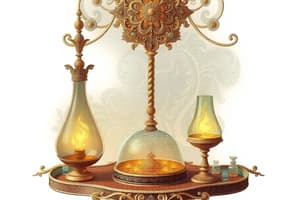Podcast
Questions and Answers
What does Boyle's Law state?
What does Boyle's Law state?
- The volume of gas is directly proportional to the temperature.
- The volume and pressure of a gas are always constant.
- The pressure of gas is directly proportional to the temperature.
- The pressure of gas at a constant temperature varies inversely with its volume. (correct)
Which law states that the volume of gas is directly proportional to its temperature?
Which law states that the volume of gas is directly proportional to its temperature?
- Ideal Gas Law
- Gay-Lussac's Law
- Boyle's Law
- Charles' Law (correct)
What are the Basic Gas Laws?
What are the Basic Gas Laws?
Boyle's Law, Charles' Law, Gay-Lussac's Law
What do the Combined Gas Laws state?
What do the Combined Gas Laws state?
What are the Ideal Gas Laws formed by?
What are the Ideal Gas Laws formed by?
Match the following terms with their definitions:
Match the following terms with their definitions:
What does the Ideal Gas Law formula PV=nRT stand for?
What does the Ideal Gas Law formula PV=nRT stand for?
In the Ideal Gas Law, n stands for ____.
In the Ideal Gas Law, n stands for ____.
The pressure of a gas is directly proportional to the volume.
The pressure of a gas is directly proportional to the volume.
What temperature scale must be used in gas laws?
What temperature scale must be used in gas laws?
Flashcards
Boyle's Law
Boyle's Law
The pressure of gas at a constant temperature varies inversely with its volume.
Charles' Law
Charles' Law
The volume of gas is directly proportional to its temperature.
Combined Gas Laws
Combined Gas Laws
Describe the relationship between pressure, volume, and temperature of gases.
Ideal Gas Laws formation
Ideal Gas Laws formation
Signup and view all the flashcards
PV=nRT (Ideal Gas Law)
PV=nRT (Ideal Gas Law)
Signup and view all the flashcards
What does 'n' stand for in PV=nRT?
What does 'n' stand for in PV=nRT?
Signup and view all the flashcards
Temperature scale for gas laws
Temperature scale for gas laws
Signup and view all the flashcards
Study Notes
Gas Laws Overview
- Boyle's Law: Pressure of a gas is inversely proportional to its volume at constant temperature and amount.
- Charles' Law: Volume of a gas is directly proportional to its absolute temperature at constant pressure.
- Gay-Lussac's Law: Pressure of a gas is directly proportional to its absolute temperature when the volume is constant.
Combined and Ideal Gas Laws
- Combined Gas Law: Relates pressure (P), volume (V), and temperature (T) while keeping the amount of gas constant.
- Ideal Gas Law: Formulated as PV=nRT; encompasses all variables and can be used to find mass once moles are determined.
- P = pressure
- V = volume
- n = amount of gas (moles)
- R = ideal gas constant (dependent on pressure unit)
- T = temperature
Variables in Gas Laws
- Amount of gas (A): Measured in moles (n).
- Pressure (P): Can be expressed in various units such as kPa, mmHg, atm.
- Temperature (T): Measured in Kelvin (K), calculated as K = °C + 273.
- Volume (V): Volume of gas measured in liters (L).
Formulas for Gas Laws
- Boyle's Law: ( P_1V_1 = P_2V_2 )
- Charles' Law: ( \frac{V_1}{T_1} = \frac{V_2}{T_2} )
- Gay-Lussac's Law: ( \frac{P_1}{T_1} = \frac{P_2}{T_2} )
- Combined Gas Law: ( \frac{P_1V_1}{T_1} = \frac{P_2V_2}{T_2} )
Helpful Mnemonics
- Boyle's Law Hint: "Boyle is the V.P. of Gas Laws" (inverse relationship).
- Charles' Law Hint: "King Charles was 'V'icious" (direct relationship).
- Gay-Lussac's Law Hint: "P.T. is gay" (joyful correlation between P and T).
Important Notes
- Temperature for gas law calculations must always be in Kelvin.
- The relationships established in these laws are essential for understanding gas behavior in various conditions.
Studying That Suits You
Use AI to generate personalized quizzes and flashcards to suit your learning preferences.




